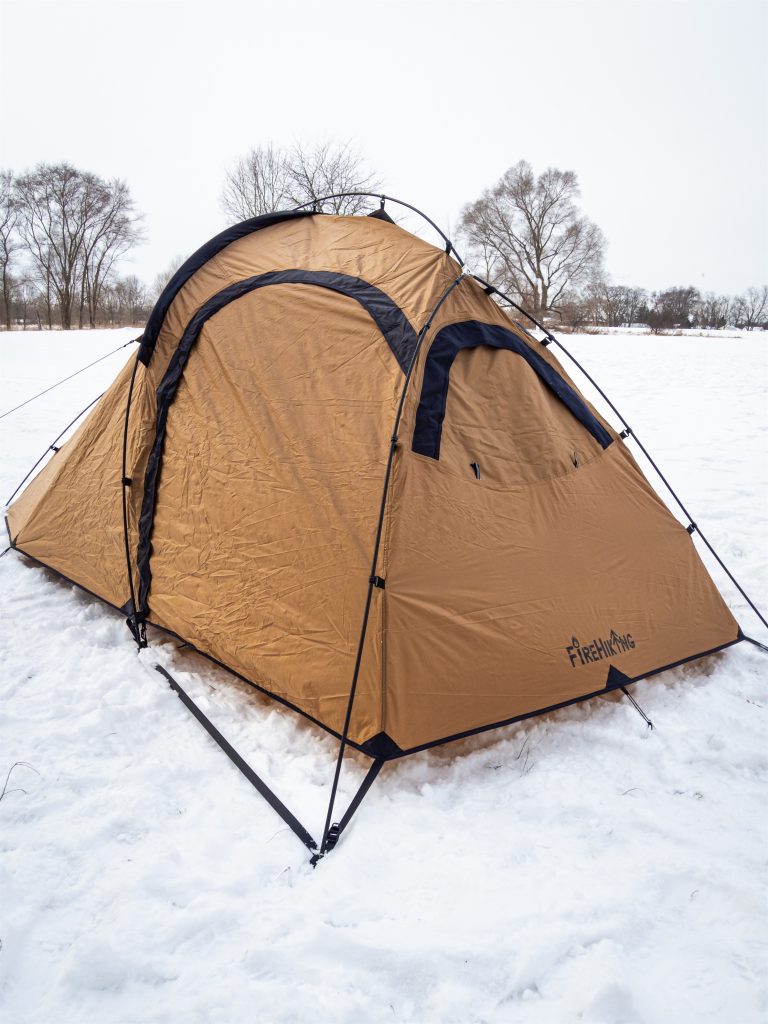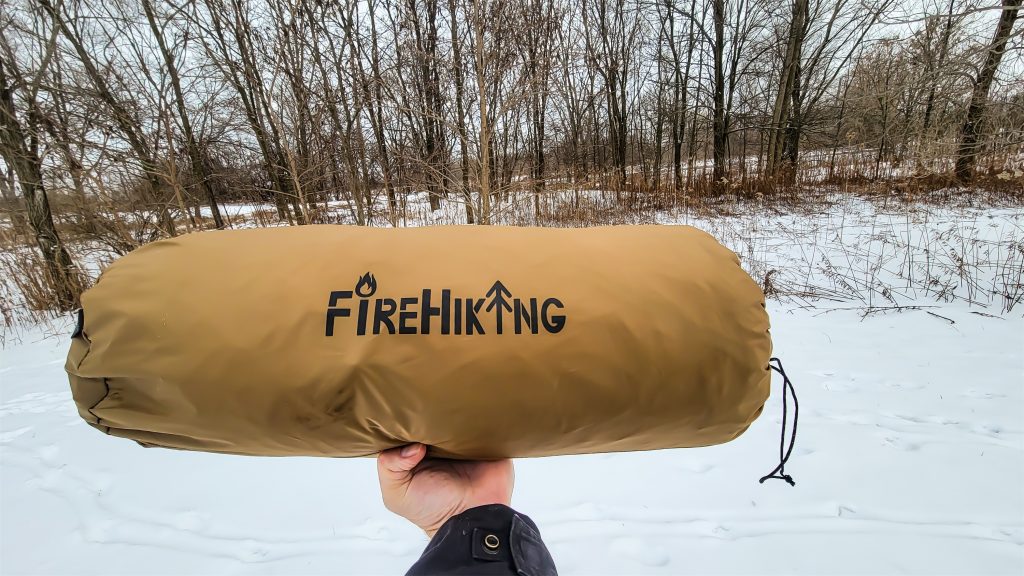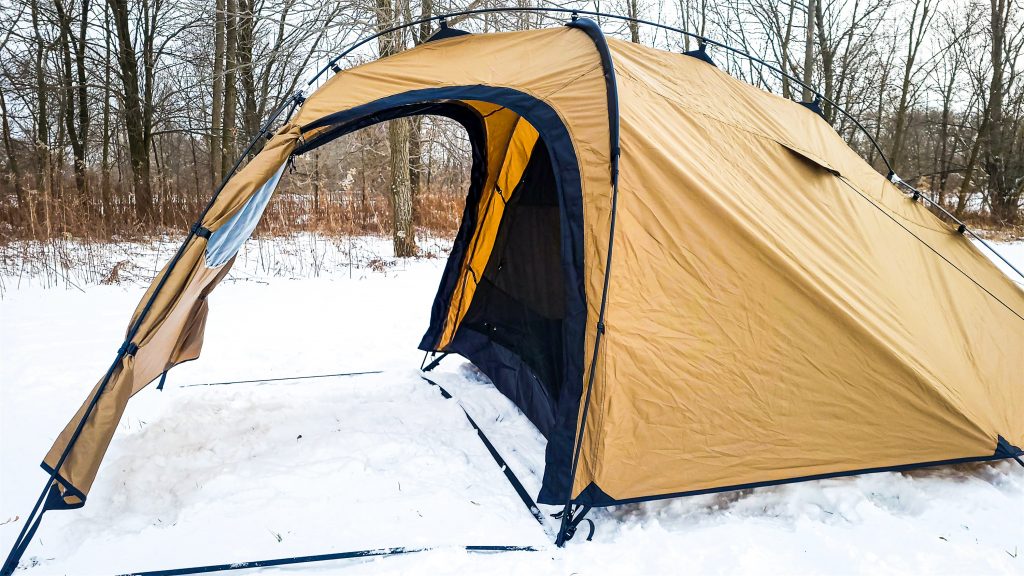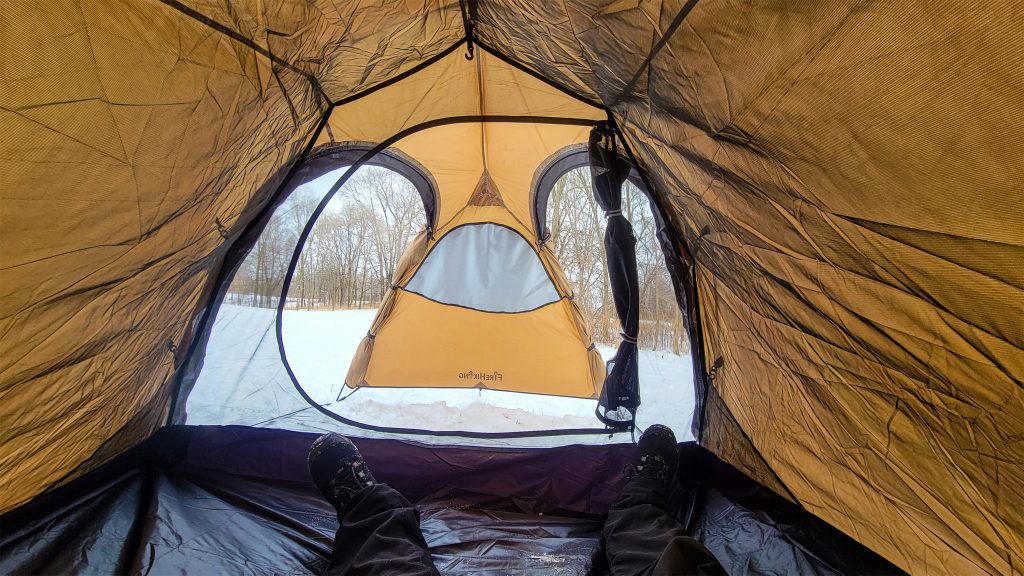Into the Wild with the Firehiking Fireden Hot Tent: A First Impression | Perrin Adams
Written by Perrin Adams
Disclaimer: This article is reprinted with permission from the original author
Original article: Into the Wild with the Firehiking Fireden: A First Impression

The Firehiking Fireden, a lightweight hot tent weighing in at under 8 pounds, offers outdoor adventurers a unique portable shelter. Engineered to accommodate a wood stove with its integrated stove jack, this tent holds a promise of warmth and coziness in the backcountry.
The innovative design includes an open-concept vestibule and a mesh inner tent for insect protection, trying very hard to extend its usefulness into other seasons.
This tent was provided to me on the basis that I give an unbiased opinion. I did not reach out to this company and I have never used this company’s products before. Aside from a new shelter to use in my travels, there is no other gain for me. That being said – there are both highs and lows to this tent.
This first impression will talk about the initial setup of this product, examine the materials and construction quality, and explore the tent’s optimal use cases. I will say that it has not been fully tested by me yet, these are just observations from someone who has used four-season tents for many years.
Firehiking Fireden Specifications
The Firehiking Fireden is a lightweight, 4-season tent that caters to those who want to camp year-round. Although the intended use market is for those who want to go winter camping, due to its ability to house a wood stove.
The main pole is integrated into a three-way fixed design where all of the different points of the main pole fit together to give it rigidity. There is one other pole that provides structure for the divider between the two sections of the tent.
Here are the specifications according to the website:
- Material: Made of 20D 400T nylon fabric
- Coating: Tear-resistant silicone-coated for enhanced durability
- Waterproof Rating: A PU3000mm rating which is decent waterproof performance for less stormy climates. (PU4000mm rating for the outer floor).
- Inner Tent Fabric: Crafted from 20D nylon for added breathability. The floor is a 150D Oxford Cloth.
- Packed Size: 20.9in x 9.1in x 6.3in
- Deployed size: 131.9in x 72.8in x 51.2in
- Product Weight: Light on the scales at 7.1 pounds, perfect for backpacking
- Peak Height: Reaches a peak height of 4.3 feet
For the inexpensive price, there will be of course some sacrifices in quality, but the overall feature roster isn’t terrible by any means.

What’s Included in the Bag
When you first unroll the tent all of the needed components are wrapped inside. The stuff sack itself was a traditional drawstring style, rather than the zipper style you see with other companies.
Here’s what you can expect inside the bag:
- 1 x hot tent
- 1 x inner tent
- 11 x tent pegs
- 3 x guylines
- 1 x stove jack
- 2 x tent poles
- 1 x tent bag
All items were present and accounted for which was nice to see. Sometimes it’s hit or miss with some of the components in products that are mass-produced. And you know how much I hate missing guylines so it’s good to see them included too.
Size and Comfort
The Firehiking Fireden’s interesting design extends to its interior, where it features a mesh inner tent capable of protecting occupants from summer pests while allowing for airflow. Something I noted is that you can use this tent without the mesh inner attached.
The integrated stove jack might reduce costs as extra velcro is not being used, however, a removable stove jack would have made it easier to replace in case of damage. If this one fails for some reason I will have to cut it out and stitch in a new one.

With dual doors on opposing sides, the front layout supports hassle-free entry and exit, and when you’re doing a wood dump that is very important. Although, having to crouch to get in and out of the tent can become tiring, and dirty. So if you’re not able to do that repeatedly then this may not be the tent for you.
Although it could technically house two adults, I would say the space offers a more comfortable experience for a solitary camper and gear instead, leaving the vestibule for the woodstove and tent.

Set-up Experience
Setting up the Firehiking Fireden tent was largely intuitive and straightforward, a good thing given there were no instructions included. However, there seldom are instructions for these kinds of tents.
The main pole was large, and all connected as it is the main spine of the tent, with a smaller one complementing it; their assembly was a familiar process.
I was grateful for the simplicity of only having to thread a single pole through designated sleeves – a task that, despite years of camping, sometimes still proves to be a bit of a struggle.

The tent’s peak has a fixed three-way structure, which connects to hanging points designed to facilitate a quick and secure set-up.
I like this setup as it ensures ample interior space since it pulls the roof upwards. The clips used to secure the fly to the frame are robust; however, my concern lingers about their durability in extremely cold temperatures where they could snap under undue force.
This clipping system, which I find prevalent in many 3-season tents, can lead to sagging over time with repeated use – an outcome I hope this tent will avoid.
I’d like to say that staking the tent into place was a breeze, but the ground was frozen so a couple of the stakes got bent in the process. The tent stakes did seem rather weak for the task. I have many replacement tent stakes in my kit, so I didn’t really mind, but for someone who doesn’t, it could be a problem during winter camping.
Affixing the mesh inner was not only simple but also enjoyable. It’s always satisfying to see how taut you can get these inner tents to be. The clips connecting to the mesh inner were easily within reach and at no point did I have to be in an awkward position to clip in the bottom. With other tents, sometimes it feels like you have to do a bit of yoga to get everything clipped in.
Completing the entire set-up took about 10 minutes, making it accessible for both seasoned and novice campers alike. However, do note that a knife is required to cut an ‘X’ into the stove jack when you insert the stove pipe.

Overall Impressions
In evaluating the capabilities of this tent, it seems particularly well-suited for shoulder seasons, namely early fall to early winter, and again in early spring through early summer.
The fabric is competent at retaining heat when used with a continuous heat source, like a wood stove, but is thin enough to lose heat quickly without one. While the construction lacks significant cross ventilation, which could lead to condensation issues, the main doors do invite decent airflow.
In my opinion, the tent’s 3,000mm waterproof coating should suffice for light to moderate precipitation but may falter under the duress of continued heavy rain. Ideally, a 5,000mm rating or higher would be more effective in such conditions, though a woodstove could mitigate dampness to a degree.
Durability-wise, the integrity of the shock cords in the pole system raises some concerns; they are a notorious point of failure over time, though they seemed reliable upon my initial setup. I suppose time will tell, but so far so good.
The interior space accommodates woodstoves of various sizes—this extends its usability into even colder temperatures. However, the lack of a snow skirt or similar protection beneath the vestibule leaves room to introduce snow drift, winds, or rain inside.
In the end, at a price point of $199US (at the time of writing), the value for novices or those exploring cold-weather camping is initially apparent to me. Seasoned mountaineers or extended backcountry explorers might benefit from investing in a tent with a thicker material and more rugged, less breakable components for colder weather.




